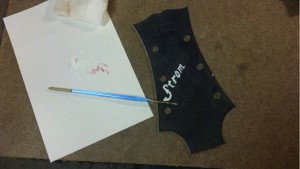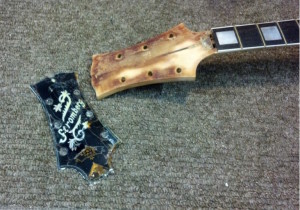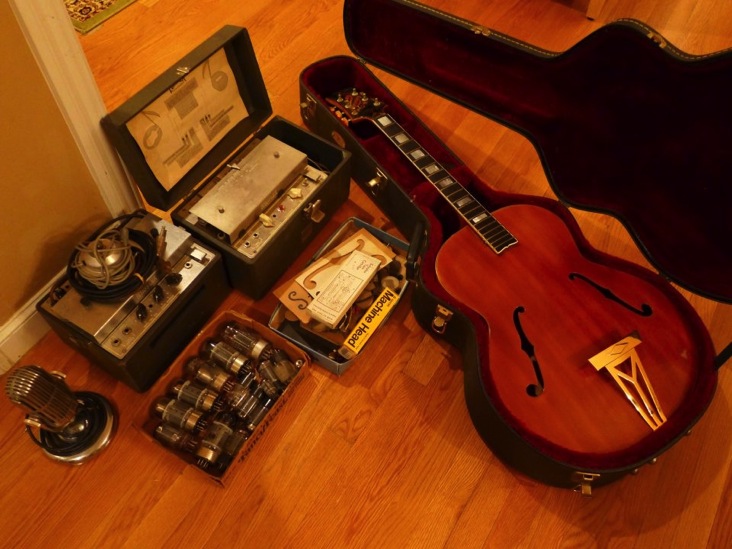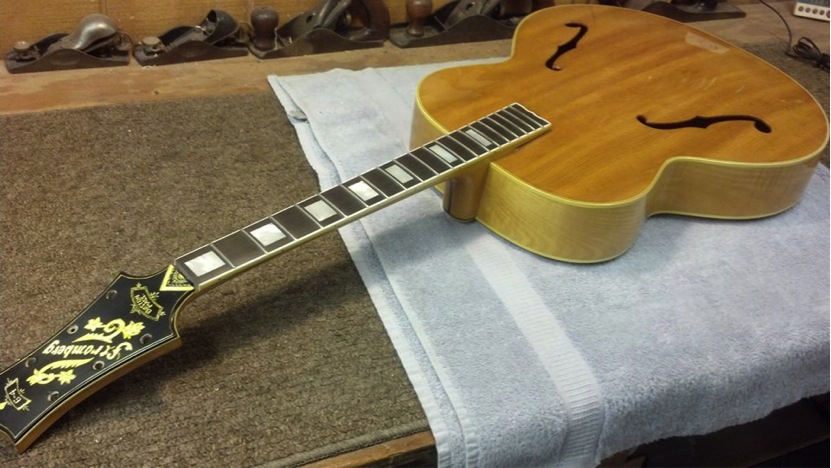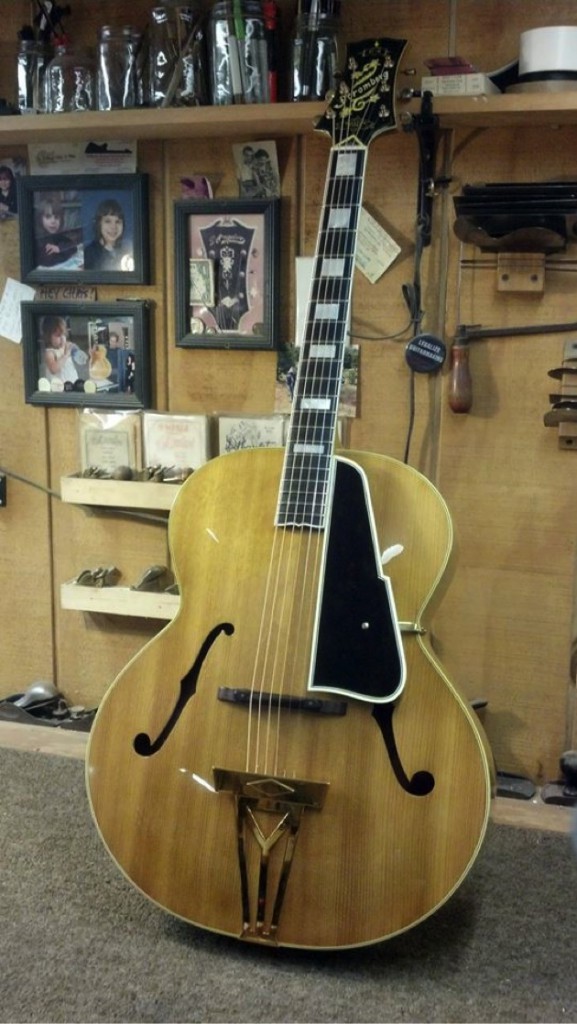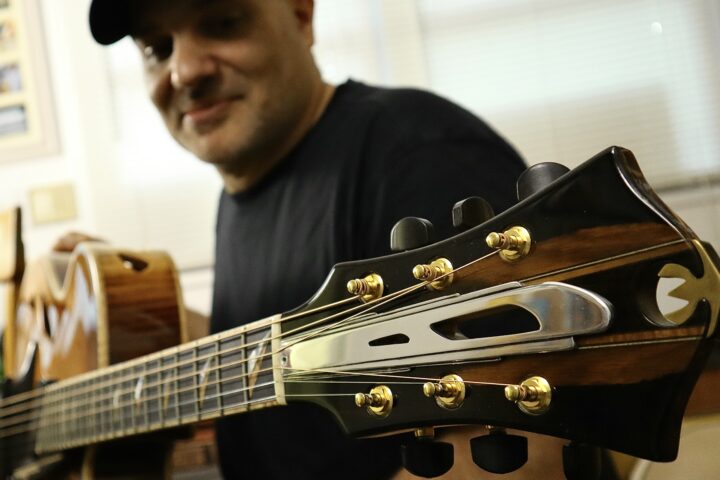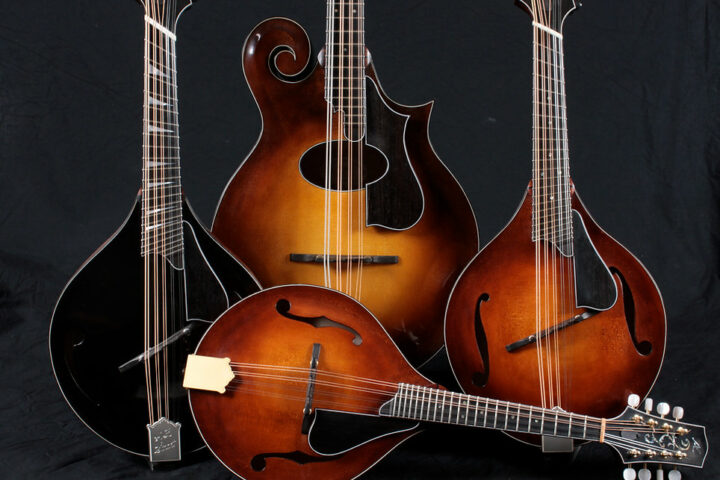You’ve probably heard the expression, “Some guitars you have to search for, other guitars find you.” This is a case of the latter. As a guitar player who loves history, I am passionate about vintage instruments. We’ve all heard guitar folklore and stories of incredible “holy grail” finds, but realistically in the day-and-age of the internet those finds are few and far between. Despite that, I still enjoy trolling eBay and the local craigslist for yet another guitar that I probably don’t need. Which brings me to the story of a legendary guitar that made its way to me through a series of unlikely, but serendipitous events.
On a winter’s night back in March 2013, I sat down in my chair with the laptop to enjoy some TV while trolling the musical instruments section of the Boston craigslist. I had barely got through the first few new listings when amongst the $50 cardboard guitars and used effects I came across the following ad:
“Have a beautiful Stromberg G-4 jazz guitar SN#615 circa 1954 (?) in need of restoration/good home. Guitar was taken out and last played in the 80’s.has sat unstrung since the 90s when my dad attempted his own restoration. Mom got sick with cancer in 95 and the guitar went away never to see the light of day until now – 3 years after dad’s passing from his own bout with cancer. I have the pick guard and all of the pieces to the guitar, but these will definitely need some conservation/restoration work. The neck is straight and the body is pristine and there are no dings or dents that I can discern anywhere. Be warned – I’m cagey about selling this guitar. It “needs” to go to the right home. I, unfortunately, am not musically inclined or it would stay with me forever. I’ve left the price open – however I have seen these sell for $20K and more. Given the condition of this one I know that it will never pull that kind of cash, but it *is* a very rare Stromberg. Make a reasonable offer and we’ll discuss it” Hank K.
My first inclination was that the listing is probably a hoax, thrown out there to elicit calls from deal seekers searching for a quick flip. But then, after reading the ad a second time, I was touched by the sincerity of the story. As I scrolled down there was a low resolution, dark picture of what looked to be a caramel colored archtop guitar in a case with no bridge, pickguard or strings. I could see that the f-holes were cut very elegantly like on a high quality cello or violin, and then there was that trademark “Stromberg” headstock overlay. I didn’t hesitate any longer and fired off an email, not really expecting to hear back.
“Hi, I saw the Stromberg on Craig’s List. I am a player and collector and I will tell you that this is a masterpiece guitar. As Craig’s list is generally bottom feeders, you may want to sell it through an experienced vintage dealer. I’d be glad to give you some information to help sell it. I am very knowledgeable about rare archtops and would love to see it”
This would start an odyssey that both Hank (the seller) and I would embark on to try and determine what exactly this unique guitar was. Throughout the months of March and April 2013, we would correspond through email in an effort to identify the model to get an accurate appraisal so that Hank would be comfortable with its sale. The problem at hand was that this particular Stromberg had a very unique set of attributes including a short scale length (24 7/8″). What was even more intriguing is that the guitar was designated a “G-4” model. I was familiar with G1/2/3, G5, Deluxe, Master 300/400 etc. but never had I encountered a G-4. The questions kept spawning even more questions. History tells us that all Stromberg archtop guitars were custom orders and the client could pick and choose different features, but most guitars stayed within the previously mentioned model nomenclature. If this was the case, why would Stromberg produce a custom variant, but then give it a new model designation (G-4) without intentions of producing more of that model? Why could we not find any evidence of a G-4 model or any other examples?
After hitting a wall, I recommended that Hank get a formal appraisal from Gruhn Guitars in Nashville. After waiting a few weeks, Hank hadn’t heard back on the appraisal so he decided to take it to a local vintage dealer. Hank emailed,
“My biggest question is “what do I actually have? I can’t find documentation anywhere on a G-4 Stromberg model. None of my web searches pull up anything remotely like it.”
I could completely understand his frustration. Despite hours of searching and asking people knowledgeable about archtops, no one could find any information on a Stromberg G-4 model. My hope was that he would find out more information once the local vintage dealer had a chance to inspect the guitar in-hand. As luck would have it Hank had a very good meeting…
“So the meeting went well – I did find out that the guitar had been refinished (most likely by my dad) but otherwise it’s in fantastic shape, which I think is evident in the pictures I have sent. The appraiser pulled out a G-3 he had that looks very similar to the G-4 that I’ve got, and he thinks like you so that this was a special order. Now that this hurdle has been overcome and I know more about it from someone I believe to be an expert – would you still like to come by to take a look? I know you’re looking for an archtop to play-will the fact that it’s been refinished be a problem for you?
I was excited to finally get the green light to see this guitar in person after nearly two months of emailing but the “r” word (refinished) is always a concern especially for acoustic instruments. I was still intrigued by the guitar and if it was in my ballpark price-wise because of the refinish, well then, maybe that’s not a bad thing. I quickly returned an email to Hank and arranged a day to meet him at his house and finally see the guitar.
On the evening of April 1, 2013, I pulled up in front of Hank’s house. He met me at the door and led me downstairs. Even though it was our first in-person meeting, it was almost as if I had known him for a long time after all of the emails. Hank recounted the story on how his father, who was the original owner, purchased the guitar at Stromberg’s shop in Boston in the early 1950s. Hank’s dad, “Hank Sr.” was in a country western swing band with his wife who also played the bass and guitar. It was very sad to hear how Hank’s mom became sick with cancer and passed away. And then to hear how Hank Sr. always had intentions to restore the Stromberg, but passed away from his own fight with cancer. Clearly this transaction had to be handled with the utmost respect for the family and I had to make my intentions and plans for the guitar known. I told Hank that if he sold me the Stromberg, I would see that it would receive the highest grade restoration to return it to its former glory. We ended up agreeing on a price and I brought the old guitar home with two old Echoplexes and some power tubes that Hank also sold me.
I was excited to have been able to purchase the Stromberg, but as part of its purchase I had made a promise. In becoming the next steward for this great instrument, I took on a moral obligation to get this guitar restored properly. This was not going to be an inexpensive proposition and I needed to get a commitment from the right luthier. Before going through the expense of a museum quality restoration, I also wanted to be sure that I liked the guitar’s sound and playability. As it was currently in an unplayable state, I arranged to bring the guitar to Master Luthier Peter Kyvelos of Unique Strings for a setup.
On a sunny day in April I walked into Pete’s shop and opened the case. He was both surprised and shocked. He was surprised that an old Stromberg just walked into his shop, but he was also upset that it had been refinished. Pete is familiar with Strombergs, having done expert headstock overlay reproductions and repairs for some of the world’s finest examples. What I didn’t know was that Pete was also good friends with Stromberg historian Jim Speros. Pete asked if he could call Jim to come down and have a look at the guitar. I was very excited to find out about Jim and I agreed to have the guitar set up and left it at Pete’s shop.
That very afternoon I received a call from Jim. He said that he was at Pete’s shop inspecting the guitar and had never seen a model G-4. He told me that he had tracked and logged the serial numbers of Strombergs and had previously assumed serial number 615 was a Deluxe. He said that my guitar was a 1951 Stromberg G-4 that had been a factory natural finish. It had the single transverse brace and measured 17 3/8″ across the lower bout.
What he said next took me by surprise – he had seen a picture of the guitar sent to him by George Gruhn in identifying the model. Gruhn left Jim an email stating that someone in the Boston area was inquiring about an appraisal! (I almost dropped my iPhone.) He then went on to say that he was in the process of getting back to George Gruhn, but they hadn’t connected yet. They did connect and Jim provided information.
The guitar establishes that the G-4 was the non-Cutaway version of the popular G-5 model Cutaway model, and this particular guitar shares the short scale length. It maybe the only one that is in existence, according to Jim.The following week I met Jim in person. Pete had done a nice job of setting up the Stromberg and when I strummed the first chord I couldn’t believe how wonderful it sounded, clear, complex and with plenty of volume. I’ve played many vintage D’Angelicos and L-5s but this guitar’s sound was more of a cross between a pre-war Martin D-28 and a Gibson Jumbo. It was not only a great rhythm instrument, but also a killer solo guitar. That sealed the deal, this guitar was a keeper and the next step was determining the best luthier for its restoration.
Enter Cris Mirabella of Mirabella Guitars. I have long been aware of Cris’ stellar reputation of restoring and repairing important D’Angelicos, D’Aquistos and Strombergs, not to mention his groundbreaking original designs. After telling him the story of this particular guitar, he graciously agreed to take on the project. Upon receipt of the guitar, he told me he was impressed with the premium woods and through the restoration process discovered that the G-4 had the very same specifications of Hank Garland’s G-5 Stromberg, minus the cutaway.
Over the course of 14 months, Cris painstakingly brought the Stromberg back to its original glory. His attention to detail and commitment to the original specification was just amazing. I picked up the old Stromberg in July 2014 and still can’t believe that I am its next owner. I immediately emailed photos of the restored G-4 to Hank and asked if this guitar could carry the name, “The Hank Kuczynski Stromberg,” in honor of his dad. He agreed. In my 30 years of guitar playing and collecting I’ve learned that there’s only one thing better than a great vintage guitar… and that’s a great vintage guitar with a story!
So there you have it… the 1951 Stromberg G-4 found on craigslist. I wasn’t searching for a historically important guitar, and I certainly never thought I would have the opportunity to own one but now I am honored and grateful to be part of its story. I guess the moral of this story is keep searching: it’s part of your musical journey and it’s in our DNA as guitar players. You never know when a great guitar is going to find you.
